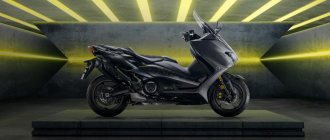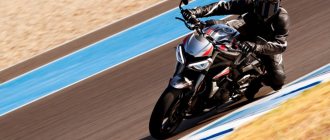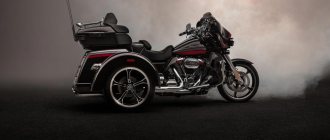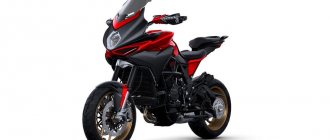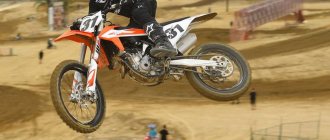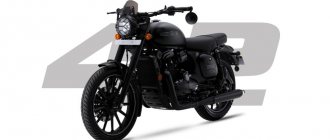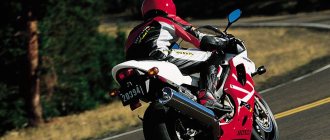It’s clear that I couldn’t miss the chance to ride my two favorite sportbikes, the Yamaha YZF-R1 and R1M - on one of the best tracks in the world - I couldn’t. But it's strange that Yamaha decided to invest a significant amount of money in renting this track to introduce the R1, since these sportbikes have changed very little since 2015. Why did they invite journalists from all over the world, put them up in a great hotel and give them a huge press release?
Impact of Euro5 on Yamaha YZF-R1 and R1M 2022 sportbikes
In simple words it sounds like this: Euro5. The heartless reality of internal combustion engines is this: they have exhaust. And even though we are talking about air pollution, even about noise, there are documents all over the world that prescribe the limits of these pollution - the maximum levels of noise and hydrocarbons that the device can emit. Euro5 is the most stringent framework that motorcycle manufacturers are forced to fit into today. No one, not even Yamaha, has the right to ignore this. Manufacturers typically control emissions by installing catalytic converters and other components to burn off unburned fuel, and while this does reduce pollution, it also reduces engine power, and consumers don't like that at all. What to do? Make the engine bigger.
A larger engine is absolutely not an option in the case of the Yamaha R1, which is actually a sportbike of a certain category, for which the limit is set at 1000 cc. cm. So instead of increasing the cubic capacity and new afterburning options, Yamaha focused on increasing the efficiency of fuel combustion, thereby making the exhaust cleaner in its original form.
Yamaha YZF-R1
Victor Kryukov
AES-MOTO Technical Specialist
On the dyno, the YZF-R1M produced 191 horsepower. With. (on the shaft) - it is clearly visible that Yamaha did not rely on maximum engine power. Everything is quite standard and uninteresting: a torque model for controlling the electric damper, a high compression ratio - almost everything is inherited from the YZF-R1 of previous modifications. Observing trends in technology development, we can confidently say that engine building has reached a certain dead end, having reached a power of 200 hp. With. from “liter” on serial equipment. The YZF-R1M focuses on electronics. The algorithms of the internal combustion engine control unit remained unchanged. But all systems have been transferred to ARM processors, and the old proven real-time code has been replaced by an operating system of Yamaha’s own production (possibly variations on the theme of Linux or Android). The transition to new software made it possible to implement modern traction and wheelie control algorithms, previously available only in sports control units - such as Motec or Marelli. Another interesting feature was the introduction of the 802.11B wireless interface into the motorcycle, better known in the wider community as Wi-Fi. Via a radio channel using the proprietary YRC Set-Up & DAC utility, at a fairly decent distance from the motorcycle, you can change the configuration of the electric throttle, control mechanisms, traction control and receive feedback in the form of a data stream from on-board sensors. Combine a radio channel with a CAN bus? On the one hand, this is a rather interesting function that gives the “advanced user” the ability to record and subsequently analyze data. On the other hand, in “computer” language, this is a clear Backdoor, and there is every chance that, having thoroughly understood the communication protocols with a motorcycle, in the hands of a competent “information security specialist”, the YZF-R1M can become a radio-controlled toy riding on the track .
Tags
Yamaha
What's new in the 2022 Yamaha YZF-R1 and R1M?
When Yamaha announced the 2022 R1 and R1M, they didn't even nominally increase their power. These litrosports are pure monsters in their current form, and tuning manufacturers offer various ways to squeeze out a couple more horses, so by paying all the attention to a cleaner exhaust (and therefore, a detailed study of the timing phases, flares, fuel maps), the engineers did not go wrong.
In fact, it only sounds simple: the cleaner exhaust required modifications to the cylinder head, where the intake ports were shortened and the volume increased by 12% after the throttle valves. The injectors have moved to the top of the throttle body, and the atomized fuel follows a more direct path to the intake valves. The injectors themselves are now of a different model, with 10 holes instead of 12.
For effective heat removal, the coolant channels at the outlet windows are enlarged. The new shape of the rocker arms ensures more stable timing operation at high speeds. This is also achieved thanks to a new camshaft profile with the same valve stroke and phase overlap figures. After air enters the engine and burns fuel, the exhaust gases enter the exhaust section, where the catalysts are located closer to the engine and reach operating temperature earlier, burning the exhaust faster and more efficiently.
Inside the engine, the oil pump impeller has become 2 millimeters narrower, reducing the load on the engine (its efficiency is more than enough, especially at high speeds). In the crankcase, the oil channels were slightly reduced, as was the piston cooling nozzle. In the crankshaft, the oil channel was also slightly reduced (by 0.5 mm), but the liners, on the contrary, were increased by 3 mm. This improves lubrication and reduces the likelihood of oil starvation, especially when abruptly closing the throttle from high speeds - such as, for example, when braking before a hairpin.
Yamaha YZF-R1
On the chassis side, the stock Yamaha R1 fork from KYB has been fitted with a new piston and shim set. The spring stiffness has been slightly reduced compared to the previous version (from 18.12 N/mm to 18.0 N/mm). The KYB rear shock is also slightly modified to match the fork.
After listening to complaints about poor brake feedback, Yamaha fitted the new R1 with different pads that the company says provide better brake feel, more maximum braking force and roughly the same level of initial force. In addition, the Unified Brake System has been removed, and the ABS device has become even more compact.
Yamaha YZF-R1
The current generation of Yamaha R1, which appeared in 2015, became the first Japanese litrosport to implement a full set of electronic assistants based on the 6-axis inertia measuring device, which is increasingly used in new motorcycles. Traction control and slide control with lean angle tracking were two important features returning for the 2022 model, along with lift and launch control, quickshifter and ride modes.
For the first time, the 2022 Yamaha YZF-R1 features full e-throttle. Previously, the throttle was controlled by cables connected to a sensor, but now electronically controlled throttle valves do away with cables entirely. The position of the throttle grip is read by a magnetic sensor, which sends a signal to the damper actuator.
Another new development is the ability to customize engine braking (EBM). This system works taking into account the selected gear, rpm, throttle position and throttle opening, and implements the user-selected level of braking when releasing the gas. EBM1 provides a standard level of engine braking, while EBM2 and 3 provide progressively reduced levels, with even EBM3 lagging behind two-stroke engines in terms of coasting into gear.
The list of new developments continues with the brake control system (BC). This system provides a choice between two ABS operation options: BC1 provides the same level of ABS intervention as the previous R1 version. BC2 is a more sensitive version of ABS that monitors pitch and slip using an inertia sensing device. While this option probably won't be needed by professionals on the track, the BC2 has the potential to be useful on the road, where driving conditions are constantly changing and the driver's attention is divided between many factors. For racers, however, the new launch control setting (LCS) will be useful, where LCS1 provides launch at higher speeds - 9000 instead of 8000, setting the throttle opening angle to 41º instead of the previous 38º, and LCS2 provides the same operation.
Sergey Krapukhin
Sergey, what are your first impressions of Yamaha’s flagship?
Speaking of the engine, the power delivery is very smooth, from the lowest revs to the top revs. In other words, you are always “on the moment”, there is no problem that the previous YZF-R1 had when the engine “died” at high speeds. Now the power “stretches” throughout the entire tachometer range, without hysterics or explosions.
What didn't you like?
There probably wasn't anything I didn't like.
Okay, let's formulate the question differently: what would you like to change?
I didn’t have time to try all the possible options for electronic intervention in the operation of the suspension - so far I’ve only driven with city adjustments, I also drove in the PWR1 power mode, intended for the track, while in the M1 mode it is possible to “manually” adjust the operation of the suspension hydraulics.
I analyzed the difference between the settings from A1 to A3, and still I would like to try to make the suspension work harder by working with the standard electronics. Then it will become clear whether it is worth changing to a cartridge suspension, without electronics, or perhaps this will be the first motorcycle (for professional track use) where it will be possible to stay with the electronic suspension at stock settings.
Do you think the average user will be able to understand and use the full potential of the YZF-R1M's electronics?
The electronics and algorithms for its operation and settings on the YZF-R1M are designed for any level of rider: if you don’t understand anything or don’t want to understand the myriad of capabilities of the motorcycle, then you can stay in the basic modes: any automatic program for the electronics, it doesn’t matter – PWR1, PWR2 or PWR3, in 90% of cases it will cover the capabilities and needs of the majority of future owners...
If you were to rank modern liter sportbikes, how would you rank them?
I have not ridden all modern liter sportbikes, so I can only evaluate those that I was able to test. My rating will probably look like this:
Yamaha YZF-R1M, Aprilia RSV4 Factory and BMW S1000RR.
The YZF-R1M, with its level of saturation with electronics and the possibilities of its adjustments and settings, is a different level of modern liter sportbikes. This motorcycle will always allow you to use new solutions and make you work with it. In other words, the YZF-R1M, with its endless potential, is like an unread book in which there is always something new to discover...
Yamaha R1M
Yamaha R1M 2020
The Yamaha R1M features more carbon fiber, updated electronics, and the latest Öhlins ERS electronic racing suspension. Like the base Yamaha R1, the M was not radically updated, but became a development of the current version. It features the latest edition of Öhlins' NPX ERS fork with updated algorithms and a gas reservoir in the fork body - a first on a production motorcycle, according to Yamaha. Like the standard R1, the spring rate is slightly reduced from 21 N/mm to 20 N/mm. Structurally, the NPX fork is not much different from conventional forks - springs, sets of washers, valves, but the valves here have a real-time electronic drive, which makes the fork semi-active. The ERS monoshock has also been slightly retuned to match the fork, with a new compression piston, different valving settings and a 4mm increase in spring preload for a slightly higher rear end lift.
As before, the standout feature of the Yamaha R1M is the Communications Control Unit (CCU) , which allows the rider to change the R1M's settings using the YRC app and see how well (or poorly) it rides using the Y-TRAC app, now available on iOS. The CCU records data from the GPS, inertia measurement device and engine ECU, allowing 16 channels of telemetry to be analyzed from each lap of the track - essentially providing a watered-down version of the data a race team needs to help their driver go faster. If you ride with a faster mate on another R1M, you can compare data from both sportbikes and highlight the strengths and weaknesses of both riders.
The Yamaha R1M also received a new front fairing, fender, side hood and tail - all made of carbon - emphasizing the exclusive appearance of the M version, and the emblem on the airbox is now numbered.
Ruben Xaus & YZF-R1M
Yamaha has finally created a worthy competitor to the BMW S1000RR, Ducati Panigale 1299 and Aprilia RSV4 Factory. In fact, it is no longer possible to draw analogies between the predecessor and the new model: they are completely different and are separated from each other by a whole generation. Probably, today the YZF-R1M is the most advanced production motorcycle in terms of electronics, which even provides the ability to control lateral slips.
To be honest, it can take quite a long time to understand the many settings that the engineers generously rewarded the new product with. For me personally, it’s most convenient when all electronic assistants are turned off. Of course, this does not mean that the electronics are not working correctly. I found engine response smoother and more predictable in the lower and mid-range than the BMW S1000RR and RSV4 Factory.
True, compared to the Ducati Panigale1299, the low and medium speed zone is not so pronounced. As for the output of the power unit in extreme conditions, I believe that here the YZF-R1M is quite comparable with its Italian and German counterparts. Of course, there are also points that I would like to change a little: let’s say, after the fourth lap at MRW and the second in Belgorod, the brakes were a little tired.
It should be noted that, unlike large tracks, on a karting track there is no place for the brake discs to be cooled by oncoming air at three-digit speedometer values, which is why on short tracks or karting tracks any problem with a motorcycle with braking systems is revealed much faster.
In terms of handling, the YZF-R1M is noticeably more interesting than the BMW S1000RR, it is lighter on the switchbacks, faster in chicanes, and sometimes gives the feeling of a 600 cc sports bike rather than a heavy “liter”. I think that Yamaha managed to bring a serious competitor to the market, and now the positions of the BMW S1000RR, just a trio of “Japanese”, as well as the Aprilia RSV4 Factory, will no longer be so strong and cloudless.
Driving impressions
Yamaha YZF-R1
While the Yamaha R1 may not have the prestige of some European competitors, it is still one of my favorite sportbikes (on the track, of course. On the road it's a pain). Few models can compete with the divine melody of the R1's offset ignition when it sings in full voice, and with the new electronic throttle the engine response to the throttle has become even better - essentially, which is the point of the cross-shaped crankshaft.
If you're familiar with the latest Yamaha YZF-R1, the 2022 model won't seem too new. Starting the day with the base model, I quickly felt familiar and comfortable, even though I hadn't driven one in a couple of years. And I hadn’t been to this track for more than 10 years, so I started with a familiarization lap, which the R1 did very well.
Let me note a few points.
First, I already talked about this - I really appreciated the instant response of the rear wheel to movements with my right hand. The Yamaha YZF-R1 produces great traction, but it's completely controllable (assuming you're not a beginner - the R1 is definitely not for beginners). Yamaha representatives didn't point this out, but the revs, especially in riding modes 1 and 2 (the two most bouncy and powerful), are much smoother than on other Yamahas I've tested. Personally, I preferred mode 2 for its slightly less aggressive kick at the start.
Yamaha YZF-R1 2020
The second thing is damn nice confidence in every sense: the Bridgestone R11 corners superbly (the stock R1s will be shod with RS11s) at any angle available to me, and the feedback is clear and understandable both from the tires and from the chassis as a whole.
Third, I relied on electronic assistants, and they did not disappoint. Ten years ago, when I last visited this track, I was riding a Ducati 1098R with the first traction control fitted to a production motorcycle. And although this was a nice bonus, it was more of a road bonus - on the track it interfered too obviously and tediously, constantly cutting off traction and making it difficult to complete the lap as quickly as possible. Ten years later, the electronic features on the Yamaha R1 are barely noticeable. This is the best evidence of how far we have come, and it makes us look forward to the further development of these technologies.
At the end of my third and final ride (which was the sixth for the bike, since we alternated in the saddle), I felt that I began to ride confidently, but the bike, on the contrary, was tired. Or rather, the tires are tired: the side support has dropped considerably. In one of the simple corners, it was necessary to open the gas as early as possible in order to get out of it as quickly as possible onto the straight, but on worn tires this led to a serious breakdown - and I would be happy to say that my skills saved me, but praise the perfect work of the traction control. control will be more honest.
Yamaha YZF-R1
Thinking back to 2015, when the first version of today's Yamaha R1 first appeared, I can clearly imagine how the adjustable wheelie control allowed the front wheel to rise under load and then smoothly return to the track. Everything remains roughly the same on the Yamaha YZF-R1 in 2022, and you especially feel it coming out of the narrow hairpin at the end of the lap. You come out of the last corner at full throttle, and really ride on the back foot. The lift control works, and you can directly feel how it is trying to figure out how much traction to provide so that you move forward, but not lift the front wheel too much. I shift up and the front lands. Personally, being able to use the gas without fear gives me a kind of serenity that allows me to go faster. It should be noted that I was driving in lift control mode No. 2. The first mode leaves the rider more control, and the braver guys I've talked to turn off the lift control altogether and work with their head, not just their right hand.
If we talk about the weak points of the Yamaha R1, then these are again the brakes. Braking power is decent and response is better, but I want more. More braking force, more sensitive initial braking and LESS ABS! Sometimes heavy braking and three quick downshifts activate the ABS for no apparent reason, especially on the rear wheel, which once forced me to go very wide and completely miss the turn.
Yamaha R1M
Yamaha R1M
I switch to the Yamaha R1M saddle on Bridgestone V02 slicks this afternoon and the impressions are... basically the same. This shouldn't be surprising, given that the main difference between the two is in the suspension. However, there is still a noticeable difference between conventional and semi-active suspension: when you load the fork with powerful braking, you feel how the electronic suspension reacts and adjusts, providing greater stability and support during braking. And all this - in a split second. The same goes for the rear suspension during acceleration.
The real difference in sensations begins when you get off the Yamaha R1M and start downloading telemetry logs. In the application on your phone you can see a huge number of parameters for driving each circle. There are 16 different data layers that show throttle percentage, GPS speed, gear engaged, and where and when the driver's aids were engaged, all overlaid on a graph and Google Maps track map. This truly is a new level of analysis for those outside of the factory racing teams.
Yamaha R1M 2020
MotoGP technologies: All the secrets of the Yamaha YZR-M1 - Evolution of development from 2004 to 2010 in detail
So, in 2004, Yamaha Racing managed to create the perfect combination for a factory motorcycle in Moto Grand Prix. The philosophy behind the YZR-M1 0WP3 continues to this day. What is it and who exactly makes Yamaha the most controlled prototype in MotoGP?
MOTOGONKI.RU, March 3, 2022 - Continuation of the history of the Yamaha Mission One project in detail - read: part one
. And don’t switch, the third part will be even more interesting!
When technology was ahead of its time
As the developers found out during the 2003 season, the reason why the pilots could not realize the potential of the engine was its ... high, but poorly controlled power: in 2003, bench tests of the engines showed figures close to 240 hp. It was also possible to achieve sufficient reliability, so it was clear to everyone that the “motor race” would not stop there, and competitors would strive to find higher performance. Masao Furusawa understood the reasons for the problems of his pilots at the very beginning of the 2003 season, but decisive changes were only made to a completely new prototype, with which Valentino Rossi eventually took the first YZR-M1 title in recent MotoGP history.
Evolution of the Yamaha YZR-M1 engine from 2003 to 2006:
Since electronics to control torque and rear wheel slip did not yet exist in 2003, engineers were faced with a non-trivial task. Lowering the top rev limit meant losing peak power and speed. Given the ever-increasing productivity, this was not a solution. But it was possible to achieve smoother engine operation overall and improved torque transmission characteristics to the rear wheel by improving the chassis geometry.
Initially, the 0WM1 engine of the 2002 and 2003 models was equipped with a cylinder head with 5 valves per cylinder, three of which worked on the intake, and two on the exhaust. In the project, Furusawa also had absolutely fantastic prototypes with 7 valves per cylinder. Here is a photo from the Yamaha Museum of one of these prototypes that never became a working model:
7 valve test prototype
Increasing the number of valves made it possible to reduce the size and weight of each of them, thus reducing inertia, providing a higher operating frequency and gas exchange performance - and increasing engine power. By the way, the 5-valve engine head from R&D Yamaha Racing migrated to serial production and became an integral part of the iconic Yamaha FZ750 dragster in Europe.
But in the YZR-M1 it... didn’t take root!
Furusawa decided to return to using a 4-valve head, which immediately brought positive results. By the way, the YZF-R1 superbike also used a 5-valve design, which was replaced by a 4-valve design in 2007 - this is a consequence of the MotoGP results, as well as the result of research carried out by Masao Furusawa’s team.
Yamaha YZR-M1 engine
Today, with all MotoGP prototypes using pneumatic valve train technology, the more precise and well-controlled 5-valve design makes sense. But in 2002, Yamaha developers ran into the physical boundaries of pure mechanics.
Another detail, which was studied for a whole year, played a decisive role in this story - we are talking about the turbulence of the flow of the fuel-air mixture in the combustion chamber. When the mixture is fed, there is always strong turbulence, that is, the “jet” forms a downward vortex, spinning clockwise. At the time of using carburetors (in 2002), it was impossible to accurately control the quality of the mixture, because air and gasoline were mixed in the combustion chamber. In the 5-valve circuit, the middle of the three intake valves was responsible for the flow of air, and the two outer ones were responsible for fuel. At high speeds, the air flow was so strong that it disrupted the structure of the vortices created by the fuel mixture, and the mixing itself occurred unevenly.
Diagram of the operation of a 3-valve intake in the combustion chamber
Accordingly, the combustion quality and engine performance decreased. The first step in resolving the issue was the transition to an injection power system in 2003. But this did not allow us to completely cope with the situation. There were two options: change the valve diameters to create a balanced system, or abandon one of the valves, creating an equal, balanced mixture formation system.
As the head of the YZR-M1 engine development team, Kimihiko Kitikawa, later explained, the 5-valve circuit stopped working effectively already at 15,000 rpm: “The valve drive technology that we used then simply did not have time to work out. We had already implemented the ability to select one of two ignition maps, but programming the valve control and mixture quality [in the injectors] for the 5-valve head added significant complexity to the project. With four valves we were successful very quickly."
- said Kitikawa-san.
Crossplane is a real revolution in engine building
Plus, in 2004, one significant innovation was made to the YZR-M1 engine, which is used almost everywhere today - a crossplane crankshaft, which instantly smoothed out the characteristics of the engine.
Crossplane crankshaft operation diagram
The essence of the crossplane is to separate the shaft into 4 sections, each of which is rotated 90°, so the pairs of pistons balance each other’s vibrations without loss of performance. This also allows you to play with the order of ignition initiation in the cylinders, which Yamaha engineers played with a lot in subsequent years.
First of all, the smoothing of the characteristics occurred because the effect of the so-called “inertial torque”, when the piston can adjust (or, conversely, brake) the crankshaft, has significantly decreased. Valentino Rossi tested the engine at Sepang in February 2004, after which he called the updated YZR-M1 nothing less than “cool”.
Implementation of a crossplane crankshaft on a Yamaha YZF-R1, similar to the YZR-M1
In addition to many changes to frame and swingarm geometry, installing a transverse crankshaft almost completely solved the problem of driver uncertainty and uncontrolled rear wheel stall. This made it possible to smoothly increase the power of the 990 cc YZR-M1 engine to 250 hp, and Furusawa became more involved in refining the chassis.
In search of the ideal
The goal for the next two years was to create optimal geometry and weight distribution for perfect cornering. These developments led Yamaha to dominate MotoGP for many years.
2003 Yamaha YZR-M1 chassis (with 5-valve engine)
Despite the lengthening of the swingarm in 2004, the wheelbase of the 2005 model became ... shorter, which made the prototype more nimble and improved steering. Yamaha engineers moved the engine further in the frame towards the steering column, making the frame itself more compact and shorter by almost 70 mm. Thus, the long pendulum began to be attached even closer to the center of mass of the motorcycle. Additional modifications were made during the season, thanks to which Rossi tested the best ever M1 with a 990 cc engine at the tests in Brno.
Without a doubt, the 2005 generation Yamaha YZR-M1 (0WP4) is considered Furusawa's most successful prototype since he took over as leader of the Mission One project.
An attempt to change the characteristics of the YZR-M1 in 2006, before MotoGP switched to 800 cc engines, led to failure. Deciding to make the engine spin up to 17,000 rpm to achieve 260 hp, Yamaha engineers made the engine shorter - increasing the cylinder diameter while simultaneously reducing the piston stroke. But this disrupted the stability of the chassis, so Valentino Rossi spent the entire season complaining about chattering (small, high-frequency vibrations of the chassis that cause discomfort and deprive the driver of confidence). It was not possible to completely solve the problem, despite changing tires from Michelin to Bridgestone. As a result, Rossi was unable to defend his title - a strange fall at the very last race of the season in Valencia deprived him of several valuable points, which were picked up by Repsol Honda's Nicky Hayden.
2006 Yamaha YZR-M1 chassis
Further changes to the chassis were carried out mainly according to the program laid down in 2004-2005: after the transition to 800 cc engines, Yamaha developers continued to play with three indicators of rigidity - longitudinal, vertical and torsional rigidity. And the further the control electronics developed, and the engines, reduced by 20% in volume, became more and more powerful (contrary to FIM expectations), the more important the chassis flexibility indicators became.
Using the 2004 YZR-M1 as a starting point, by 2010 longitudinal stiffness had been reduced by almost 30%. Torsional rigidity was initially reduced by 10-15%, but then increased by 25%. Finally, in order to reduce the wheelie effect from the non-linear (too sharp) increase in power and torque of the “nervous” 800 cc engine, the frame and swingarm were “allowed” to flex 20% more actively than during the more linear performance of 990 cc engines:
Until 2011, Yamaha kept the 2006 frame concept virtually unchanged.
The era of control electronics
To compensate for the loss of power and speed from cutting 200 cc, the manufacturers had to raise the rev red zone. In the case of the 2007 Yamaha YZR-M1, this meant +500 rpm, but then had to add more.
And here no one could do without electronic components, the names of which we know by heart today, since they are found in almost all modern motorcycles:
Ride-by-wire
or a contactless throttle control - a necessary element in a system with electronically controlled throttle valves, when the pilot does not have a direct (hard) connection with the throttle via a flexible metal cable: the opening and closing of the throttle valves is controlled by the ECU unit through precise servos.
Traction Control
— control of torque and power transmission to the rear wheel by determining the moment when the rear wheel begins to stall. At first, everything worked by comparing the speed of rotation of the front and rear wheels, taking into account the error and a known tolerance (the rear wheel always rotates a little faster). Now control is carried out through complex calculations based on data from the inertial unit (IMU) - acceleration, position of the motorcycle in space, driving dynamics, plus comparison of indicators over a certain period of time.
Engine Brake
- Engine braking control, which is the use of engine inertia to slow down the rear wheel, allowing for smoother and more effective braking along with aggressive braking by the front wheel. EB engagement is controlled by electronically controlled slipper clutch stiffness, altering or disabling ignition and power. Also, to prevent engine blocking when downshifting is not too careful, automatic re-throttle (blip) is activated.
Launch Control
— control system for excess torque when starting from a standstill. The main idea is to give the pilot the opportunity not to think about how wide the throttle is open, but to provide him with the smoothest and most efficient start without the risk of falling into wheelie. The increase in torque is controlled by the ECU, the level of opening of the throttle valves is provided by servos - the throttle handle is usually fully open at this moment. LC mode is automatically disabled the first time you brake or release the clutch.
Wheelie Control
- a system that detects excessive growth of torque, which leads to a shift in the center of force application (from the center of mass of the motorcycle to the axis of the rear wheel). With such a displacement, the balance in the chassis is lost, and the motorcycle begins to rotate around the rear wheel. This leads to a huge waste of power and loss of efficiency in acceleration dynamics. WC cuts the ignition or reduces the amount of fuel to reduce torque to an acceptable level. IMU indicators are taken into account.
Valentino Rossi, Yamaha YZR-M1 (2006), French Grand Prix
All of these systems were fully introduced and tested in the 2006 YZR-M1, and were further refined over the next five years.
Victory is hidden in the smallest details
The 800 cc engine of the 2007 YZR-M1 turned out to be quite good and quite reliable, the chassis characteristics remained practically unchanged (that is, they were excellent by default). But one important amendment to the MotoGP regulations had an impact on the results of the season - the reduction of gas tanks to 21 liters. Taking this into account, engineers had to conduct development, looking at the efficiency of the entire system. The slight advantage of the Ducati GP07 allowed Casey Stoner to leave Yamaha without the title: the Desmosedici engine turned out to be better optimized, had less internal resistance in the CPG and, as a result, provided more economical operation. In other words, where Valentino Rossi had to switch to the “ECO Mode” of the power system, Stoner continued to fry at full strength.
Casey Stoner and Ducati took the titles from Yamaha in 2007
Conclusions were made by Masao Furusawa's team immediately, and during tests in Brno Rossi received a new engine that showed better performance and was taken as the basis for the 2008 model. They tried to implement it in 2007 already in San Marino, and the update brought Rossi victory at the Portuguese Grand Prix, but it was no longer possible to catch up with Stoner.
But in 2008 and 2009 the YZR-M1 took off. First of all, the power of the 0WS5 engine was increased by 10% due to total optimization of the entire system. The pneumatic valve drive system, which has become a new trend in MotoGP, has been constantly improved, and in 2008 it was immediately lightened by 40%. The design of the CPG was improved (the cylinder diameter was slightly increased, the design of the pistons and oil rings was changed), which made it possible to reduce friction costs by 14%.
Valentino Rossi wins his 9th world title on a Yamaha YZR-M1 (2009), Malaysian Grand Prix
Rossi won his 8th and 9th world titles, both by stoppage. And in 2010, after Rossi’s injury, the Yamaha banner was proudly carried through the championship by Jorge Lorenzo.
All three seasons brought triple crowns to Yamaha, but also some disappointment. At the end of 2010, tensions between Valentino Rossi and Jorge Lorenzo reached a breaking point, leading to Rossi's emotional departure to Ducati. In addition, in the wake of tension, Masao Furusawa also decided to retire. The project leader could have stayed in the company for another 3 years, but without Rossi he saw no point in continuing this work.
Kuichi Tsuji, Yamaha Mission One project leader from 2010 to 2019
Furusawa's closest associate, lead developer Kuichi Tsuji, was appointed the new leader of the Mission One project.
Tomorrow: Kuichi Tsuji talks about the secret behind the YZR-M1
First part: Mission One as a struggle for a place in the sun
.
So, what is next?
When discussing flagship sportbike models, we always say this, but how can we remain silent...
So what's next? What innovations await us in the next releases? With the R1 and R1M, Yamaha took its already excellent litrosport and added small but useful improvements to it. I'm almost ready to call him the favorite in his class, and certainly the best among the Japanese. This is the kind of bike that makes going fast easy, if there is one in its category. Plus, it sounds great.
Both versions will hit showrooms in October-November 2022, with the M model being available in limited numbers through pre-orders on Yamaha's official website.
Does Yamaha really sound bad? and why doesn't everyone like her?
Yes, I realized a long time ago and it is clear that you are far from a professional in this field, but since I am a meticulous person, I tried to get from you a more detailed description in all the details of the difference in the sound of these speakers. A competent radio engineer, just looking at the diagram of a device (amplifier or anything else), will tell in advance how it will work, without even listening or touching it live, and the frequency response graph can already be seen as approximately, with a high degree of probability , this acoustics will sound, because there is a direct relationship between the graph and its live sound, this is elementary physics, human ears work according to the same laws, just like the measuring microphone with which this frequency response was recorded. Why then are these graphs given if they are useless from an informative point of view? For those who are interested in this issue and have at least some knowledge of it, they will tell you a lot. And from personal experience I will say that the expectation of the listening result (by looking at the graphs) and the result itself almost always coincide in the main thing, everything else is minor nuances that do not make the main difference. And Soavo’s highs are like crazy, there is complete deafness, which is now called “neutral” and “correct” sound. Bad taste is being globally imposed on brainless ordinary people, driven people who are not accustomed to using their heads in all spheres of life, and this is done deliberately for the sake of habituation, primarily among young people. Do you often see something worthy musically on TV? But there really are just a lot of masterpieces in music, but the day and night is spent passing by worthless slag and bullshit, you only see what they allow you to see. Everywhere it is stated that the horizontal straight line in the frequency response is the “most correct” sound, and the straighter it is, the better))). So let’s completely abandon tone controls on all types of equipment, why are they needed if they “spoil” all sorts of sounds. I have a friend who listens to music in the toneless Pure Direct mode, he likes it that way, he has his own opinion on it. There are even coprophages who eat feces, and if you try to prove to him that this is not good or right, he will spit in your face. But these are not the bulk of the population, but a tiny percentage; why focus on those who are in the overwhelming minority? Music should sound beautiful and bring aesthetic pleasure, that’s what it serves. I am not a sound engineer or an audio analyst, I don’t need refined, sterile sound that is not “damaged” by anything, I don’t mix recordings at home and don’t write reports and articles about what I listen to, I’m a music lover, not an audiophile, always dissatisfied with something, clinging for any little thing, just to discredit what he hears and have something to scratch his tongue about, he doesn’t care WHAT is playing, even knock on a tambourine, he cares about HOW it plays and what he can get to the bottom of. For me, the main advantages of this acoustics are important, why it is remarkable and different from others and to what extent, I think this is a completely logical and reasonable approach. And my room is 12 square meters and the sound is excellent, I can move the speakers to another room, set it up and it will be just as good. Knowing the formula for calculating the resonance of a room (F=340/(2xL) and the basic concepts from the field of acoustics, you can achieve good sound in almost any room. You don’t even need to know much, everything is ridiculously simple. I theoretically calculated the resonance using 3 planes of the room, set the appropriate settings and tested it in practice, if necessary, moved the acoustics in the right direction, you can do everything in the reverse or random order, whichever is more convenient for you. !)))

